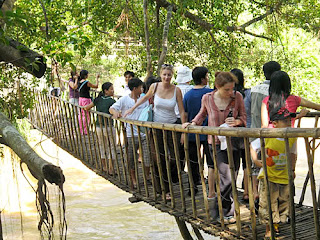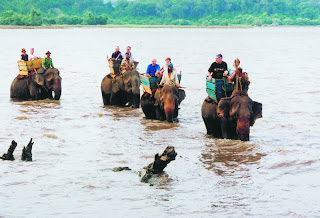Cat Ba Islands is in the South
of Halong bay world heritage. It consists of 367 islands, off the coast of Hai
Phong city and Quang Ninh province, it is far from the center of Hai Phong city
about 30 km, from the city of Ha Long about 25 km. Administratively, it is the
islands of Cat Hai district, Hai Phong city. It has been recognized as the
World Biosphere Reserve.
Cat Ba is the place between the forest and the sea blend , creating a one of a
kind landscapes . Come to this beautiful island , visitors are not only bathed
in cool blue beaches , but also can discover mysterious nature through
primitive forests on the island . Cat Ba National Park is extensive 15,200 ha
of tropical forests with system wide 570 ha rich flora and fauna , the species
is characteristic white head and Kim Giao trees .
Cat Ba Island is the giant green carpet contains many mysterious and attractive
. Worthy of the Cat Ba Biosphere Reserve 3rd Vietnam , is now recognized as a
UNESCO biosphere reserve in the world. The total area of the Cat Ba Biosphere Reserve 26,000 ha
wide , with 2 core zone ( strict conservation and human impacts ) , 2 buffer (
allowing economic growth combined with limited but conservation ) and two
transition zones ( economic development ) . Zone Cat Ba Biosphere Reserve is
the full convergence on the tropical rain forest of limestone islands ,
mangroves , coral reefs , grass beds and especially the cave system . Cat Ba
Cai Beo there remains the Halong culture , the way people have lived here 6475
- 4200 year .
With charm bestowed by nature , biological diversity and the tremendous value of the nation's history , Cat Ba has been and will be an attractive destination for domestic and foreign tourists
Over
view:
Cat Ba is the largest island
in the Bay and approximately half of its area is covered by a National Park,
which is home to the highly endangered Cat Ba Langur. The island has a wide
variety of natural ecosystems, both marine and terrestrial, leading to
incredibly high rates of biodiversity. Types of natural habitats found on Cat
Ba Archipelago include limestone karsts, tropical limestone forests, coral
reefs, mangrove and sea grass beds, lagoons, beaches, caves, and willow swamp
forests. Cat Ba Island is one of the only populated islands in Ha Long Bay,
with roughly 13,000 inhabitants living in six different communes, and 4,000
more inhabitants living on floating fishing villages off the coast. The large
majority of the population can be found in Cat Ba Town which is located at the
southern tip of the Island (15 km south of the national park) and is the
commercial center on the Island. Since 1997, Cat Ba Town has grown rapidly and
has become a tourist hub for both the Island and greater Ha Long Bay.
History
of Cat Ba Island:
Archeological evidence
suggests that people have lived on Cat Ba Island for almost 6,000 years, with
the earliest settlements being found on the southeastern tip of the Island
close to the area where Ban Beo harbor sits today. In 1938, a group of French
archeologists discovered human remains belonging "to the Cai Beo people of
the Ha Long culture, which lived between 4,000 and 6,500 years ago… considered
to be perhaps the first population group occupying the North-Eastern
territorial waters of Vietnam… the Cai Beo people may be an intermediary link
between the population strata at the end of the Neolithic Age, some 4,000 years
ago". In more recent history, Cat Ba Island was inhabited mostly by
Viet-Chinese fisherman and was largely influenced by both the French and
American wars. The Island was a strategic look-out point and bombing during the
wars often forced local residents to hide among the Island's many caves. Today,
the best reminders of the two wars have been turned into tourist attractions.
Hospital Cave, which was a secret, bomb-proof hospital during the American War
and as a safe house for VC leaders. This three-story feat of engineering was in
use until 1975 is only 10 km north of Cat Ba Town. The second attraction, the
newly built Cannon Fort, sits on a peak 177 meters high, offering visitors a
chance to see old bunkers and helicopter landing stations as well stunning
views Cat Ba Island, its coast, and the limestone karsts in Lan Ha Bay
offshore.
Cat Ba
national park:
At the heart of Cat Ba Island
lies a visually stunning and ecologically diverse national park. In 1986, 9,800
[98 km²] hectares (approximately one third of the Island's total land mass) was
annexed as Cat Ba National Park, the first decreed protected area in Vietnam to
include a marine component (Dawkins 14). It had previously been the site of a
timber company. In 2006, the boundaries of the national park were redefined, so
the park contained 109 km² of land area and an additional 52 km² of inshore
waters and mangrove covered tidal zones (langur website). The park is staffed
by 92 people, including over 60 park rangers. In 2004, Cat Ba Archipelago was
declared a UNESCO Man and Biosphere Reserve Area in order to protect the
multiple terrestrial and aquatic ecosystems as well the diverse plant and
animal life that is found on the Island. The UNESCO designation divides the
archipelago into three distinct areas, each with certain functions and
restrictions that regulates development and conservation measures on the Island
Cat Co
Beach, Cat Ba Island
The white-sand Cat Co beaches
(simply called Cat Co 1 and Cat Co 2 and 3 ) make a great place to lounge
around for the day. They are about 1 km southeast from Cat Ba town over a steep
headland; and can be reached on foot or by motorbike or taxi. The two beaches
are separated by a small hillock that can be climbed over in about 20 minutes.
Most; however; take the easier route along a new; 700m; wooden seaside walkway
around the mountain. Cat Co 2 is the less busy and more attractive of the two;
and also offers simple accommodation and camping. On weekends the beaches fill
up with Vietnamese tourists. The main beaches; apart from those at Cat Ba town
itself; are Cai Vieng; Hong Xoai Be and Hong Xoai Lon.
Monkey
Island ( Cat Dua island)
Monkey Island stay in the area
of Nam Cat, Lan Ha bay. There are 5 sandy beach here and Monkey Island beach is
the most beautiful and the biggest one. From Cat Ba town, you have to take a
taxi or motobike to Beo harbour where you go by boat to Monkey Island. It takes
you about 15 minutes, throught the floating village and many beautiful islets
with sea birds flying in group up and down.
In the past, this island was
called Cat Dua island ( Pine Apple Sand Beach island) because there is a lot of
pine apple trees on the sandy beach. In recent years, there are many tourists
come and they found many monkeys on the island then this is called Monkey
Island beside the name Cat Dua.
Monkey island is about 5 km
round with the front side are 2 sandy beaches and the back side is like rocky
mountain. The beaches here are very beautiful with pine apple trees on the
beach and many kind of green trees on the mountain.
There are about 20 monkeys on
the island. They live on the mountain, in the garden and some time go to the
beach for foods given by the tourist. Coming here, you also can enjoy the song
of the birds in the garden or see many fishes swimming in the clean water.
Monkey Island is an ideal
place for tourist holiday with many activities like play football, volley ball
on beach, swimming, snockeling or go fishing. Especially, you can do kayaking
around as the water here is calm like in a lake with hundreds of islets around.
Contact us at wood46875@gmail.com if you need any support about Vietnam travel or getting any further information about Vietnam tourism.



